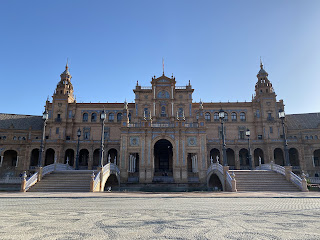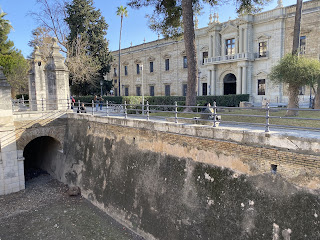I’m glad I decided to do this blog for a number of reasons. First and foremost, it keeps me from forgetting what day it is. I often have to think long and hard about what day it is, where I am, and what’s next. Yes, of course my phone has it, but who looks at that! Second, it’s been a good way to sort of recapture in my own mind what all happened throughout the day. Some days are so packed with sightseeing adventures, that I know I would have forgotten what I saw by the next day. Also, downloading this kind of thing onto a blog has allowed my more creative brain to shape how this experience has been, what I’m learning, and what I want to do with the experience when it is over.
I’ve only been in Seville for two days and I can tell you that it is not nearly long enough. Most of the other cities I’ve gone to were on target for how long I stayed. Seville, no. It is a large city that has so much to see and experience and I really have only touched on the surface. Knowing that there was so much to see and do here I packed in a lot yesterday and just couldn’t process a lot more today. I did a short (2 hour) walking tour with a group in the morning and then pretty much hung out with people the rest of the day.
Let’s get to some pictures. Yesterday I had shared a short video of an immense Plaza that I knew I couldn’t get into only one shot - Plaza de Espana. This morning, that’s where our group met and our tour guide explained that Seville hosted the 1929 World Expo and Spain wanted to show the world how rich and wonderful Spain was. So, it created this magnificent plaza and had planned to create 73 separate plazas throughout the city for all the countries that would participate. But, in 1929 something significant happened - the stock market crash. Most countries pulled out and only 25 of those plazas were created. The grand plaza - Plaza de Espana - was not diminished in any way. There are four towers, two larger ones on the outside and two smaller ones towards the center, with a center building that connects them. The four towers are to represent the four directions from which Spain looks out on the world - north, south, east, and west and the main center building unites them, creating a united Spain (which wasn’t always the case for Spain - being a united country). Then around the semi-circle there are 48 benches that represent each of the regions of Spain. Each are beautifully tiled and they go from A-Z in alphabetical order and depict something of significance about that region. I only took pictures of a few of them. The building is free and open to the public. Often, they hold public concerts in the plaza and there is a river that goes around the inside of the ring, where you can rent boats and row around. It is closed for 2 weeks every year for cleaning and guess what weeks those are - the first two weeks in February, of course!
Again, here are some pictures:
Our tour guide took us to two of the 25 plazas that were created for the 1929 World Expo - one is now a Theater and the other remains the Embassy of one of the countries, but I can’t remember which one because she also showed us pictures on her phone that we wouldn’t have time to see. Most of them have been turned into office building, public usage such as theaters or remain an embassy for their country.
We then went to what used to be the largest tobacco industry building in Spain. Tobacco was coming from the “new world” in large quantities and Spain was a huge manufacturer of cigarettes. Men were primarily workers in the factory, but then they realized that they could hire women at a fraction of the cost (nearly nothing at all) and began only hiring women. However, the women realized that there were being taken advantage of, but without a union there wasn’t much they could do. But women are far more creative then men and they began smuggling the finished product out of the factory and sold it themselves. The tobacco industry realized what was going on and dug a waterless moat around the entire building with few access points where all workers were searched. Shortly after this the work was automated anyway and not nearly as many workers were needed. By the time Franco came to power in Spain, the building had been abandoned for nearly 75 years. He thought it would be a great place to consolidate his brand of education for Spanish Students and it became Spain’s college. It is still used for this purpose today although there are many additional choices all over Seville.
In the early 1500’s Spain was overflowing with money from the “new world” and Seville was receiving huge amounts of the trade coming up the river from the ocean by the tradesmen and their ships, after all Seville was for a time the capital of Spain. But Charles III thought that it was a waste of time and energy for the ships to navigate the rivers and instead had them deposit their goods in Cadiz. This caused a huge economic problem for Seville and it declined sharply when this decision was made. However, prior to that, tradesmen would bring their goods to be sold in the open market in Seville, which was fine when the weather was good, but if it was cold or rainy, they started to bring them into the church to be sold. The church wasn’t pleased about this and had a separate building erected for them to do so. Here transactions began to be put down on paper and large amounts of “a paper trail” were created and stored in thousands of boxes inside the building. It is called “Archivo General de Indias”. It is now a museum and government office. The records have been removed and are stored elsewhere, although the museum has many pieces you can see.
























No comments:
Post a Comment